
32 minute read
More Power
from 2022-02-CCEC
FEBRUARY Quick Hits
Gridiron Grub Settle in for this year’s Super Bowl on February 13 with some next-level snacks; search for winning appetizers on carolinacountry.com/recipes.
Winter-Ready Pets
If you have pets that spend time outside, adjust food servings to provide extra calories, and check to make sure water bowls don’t freeze.
Happy Feet Stash an extra pair of socks in your car’s glove box. If your socks get wet from shoveling snow or stepping in water, you have a dry pair.
Toasty and Safe Using a woodburning fireplace this winter? Clean out ashes from previous fires, and be certain the damper or flue is open before starting a fire.
NC Co-ops Participate in National Grid Security Simulation
North Carolina’s Electric Cooperatives joined several of the state’s distribution cooperatives and more than 700 planners from across the nation in participating in this year’s bi-annual GridEx VI event, a national virtual simulation to support grid security and safety.
GridEx is the largest grid security exercise in North America and is held every two years by the North American Electric Reliability Corporation’s Electricity Information Sharing and Analysis Center. It brings together industry and government leaders to simulate cyber and physical attacks on the power grid.
The November 16–17 event provided co-op staff across the state a valuable opportunity to explore response and recovery scenarios involving simulated attacks on grid infrastructure, and to exercise cooperative crisis plans.
“GridEx is an important opportunity for our leadership and staff to practice and refine our response to crisis situations that affect our core grid infrastructure,” said Scott Brame, manager of compliance and jointly owned resources, and GridEx lead planner for North Carolina’s Electric Cooperatives. “Our participation in this simulation is a part of our deep commitment to grid security and safety, both physical and digital, and showcases our cooperative commitment to readiness.”
This year’s GridEx brought together 280 industry and government organizations in the U.S., Canada and Mexico. Electric utilities, state and federal agencies, critical infrastructure cross-sector partners and supply chain stakeholders worked through response scenarios to challenge assumptions, collaborate and enhance preparedness for current and evolving threats to the grid.
The event will return in 2023 with continued participation from North Carolina’s electric co-ops.
Celebrated Finest
Some of the winners of the 2021 Carolina’s Finest awards, featured in our November 2021 issue, are served by electric cooperatives. Two such winners were the Cape Hatteras Lighthouse (Finest NC Landmark) and Emerald Isle (Finest Getaway).
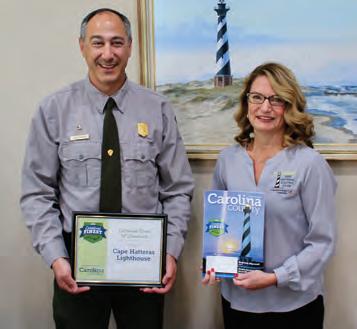
Cape Hatteras Electric Cooperative EVP and General Manager Susan Flythe with Cape Hatteras National Seashore Superintendent Dave Hallac Carteret-Craven Electric Cooperative Communications Specialist Melissa Glenn with Emerald Isle Town Manager Matt Zapp
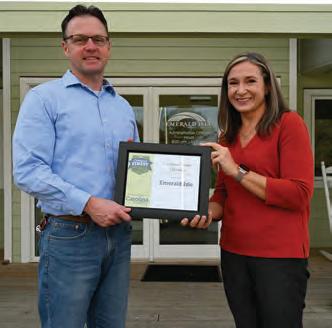
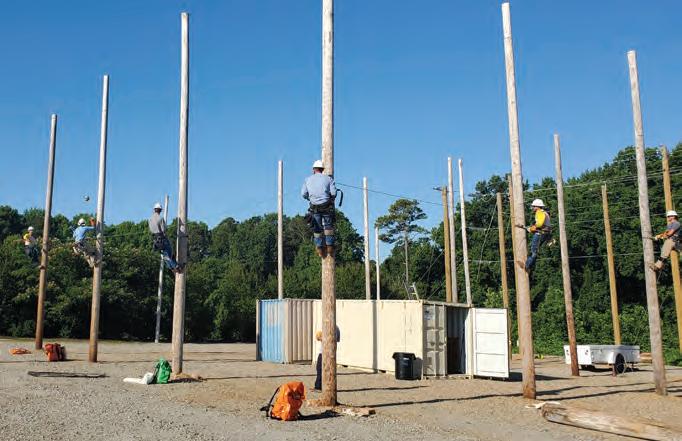
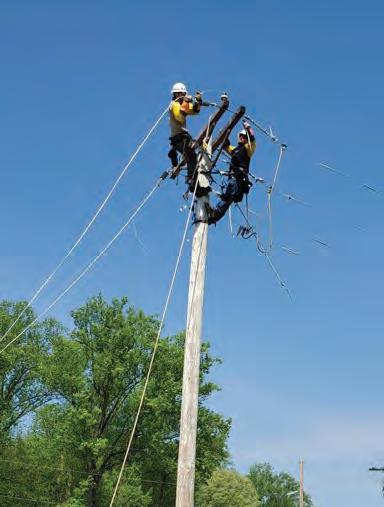
Electric Cooperative Lineworkers Gain Knowledge and Skills at Nash Community College
In 2021, 14 electric cooperative linemen completed advanced education work in the Nash Community College’s Electric Lineman Technology program. The line workers earned curriculum certificates for completing college-level credits. Teamwork and consistent training are also benefits for these students as they train with students from their sister cooperatives during each week’s class.
The program includes courses with both classroom content and practical hands-on objectives. The specially designed training field built by the North Carolina Association of Electric Cooperatives creates a training environment that allows individuals to increase skills for application when they return to their individual cooperatives. They learn skills such as overhead line construction, underground line construction and the National Electrical Safety Code. Beyond classes in line work and energy management, additional courses can be taken through the Community College System toward an associate degree such as writing and math to critical thinking, computers and communication.
Since the programs began in 1998, 23 co-op linemen have graduated with an associate degree. The community college program is supported entirely by electric cooperatives, but is also attended by linemen from Duke Energy and municipal electric systems.
In 2021, 396 co-op employees attended the NC Electric Cooperatives’ Job Training & Safety Technical Training Schools at Nash Community College, and more than 500 have registered to attend in 2022. Associate Degree
Rutherford EMC Matthew Harshman
Spring 2021 Advanced Certificate Recipients
(17 Course-Hour Credits) Pee Dee Electric Jesse Puckett Surry-Yadkin EMC Nick Newman
Summer 2021 Advanced Certificate Recipients
(17 Course-Hour Credits) Edgecombe-Martin County EMC Alton Lewis Halifax EMC Cody Pleasant Rutherford EMC Matthew Harshman
Fall 2021 Advanced Certificate Recipients
(17 Course-Hour Credits) Four County EMC Lee Bain
Halifax EMC Branden Edwards
Lumbee River EMC Joshua Oxendine Roanoke Electric Cooperative Robbie Stallings South River EMC Nathaniel Lucas Daniel Purvis
Tideland EMC Joshua Dunbar Robert Shively Tri-County EMC James Cozine
Journey To Save A Life
A casual conversation between co-workers led to a lifesaving surgery
By Catherine O’Dell
On July 13, 2021, I had the honor to be a living kidney donor for Susan Green. Susan is the wife of a South River EMC co-worker, Dana Green. One day, Dana mentioned that his wife has a rare genetic kidney disease called Focal Segmental Glomerulosclerosis, and that she would soon need dialysis and a transplant. This kind of conversation often leaves you feeling helpless, but I knew instantly that I could help. The exchange stayed in my mind and on my heart. A few days later, I asked about Susan’s blood type: A-positive, same as mine.
I couldn’t stop thinking about Susan. I did some research and found that nearly 750,000 Americans are battling end-stage renal disease, according to Kidney.org, and that more than 100,000 people in the United States are waiting for a kidney transplant. Tragically, 12 people die daily waiting for a life-saving kidney. The good news is that about 22,300 get a kidney and a new lease on life. There are approximately 6,500 transplants from living donors annually, although the majority of transplanted kidneys are from deceased donors. Organs from living donors provide a greater life span for the recipient: A kidney from a living donor lasts 12 to 20 years, while a kidney transplanted from a deceased donor lasts eight to 12 years.
These startling statistics helped me to become more focused and inspired to help. I spoke to a friend who had donated a kidney, as well as one who had received a lifesaving kidney. Both served to motivate me and were instrumental in my decision. I have been blessed with good health, and I knew that it was time to help someone else. I believe I was placed in the right place at the right time.
Once I told Dana that I wanted to be considered as a donor, she called the UNC Hospitals Jason Ray Transplant Clinic to get the ball rolling immediately.
“When Dana told me someone wanted to give me a kidney, I was so grateful, and I felt like my feet would never touch the ground,” Susan said.
The first step was a blood sample to ensure our blood type and subtypes match. We matched.
I spent two days at UNC Hospitals undergoing a series of scans and tests to ensure my kidneys were healthy and functioning properly, and to confirm that I was healthy enough to undergo surgery.
I stayed in touch with Susan every step of the way.
Once all results were returned, we learned everything looked good — except I had to lose some weight before being cleared for surgery. I started walking and dieting. It is amazing how dedicated you become when someone else’s life depends on your success. In the meantime, Susan began dialysis, a step she was hoping to avoid, but ultimately made her healthier for the surgery.
The weight and I had parted ways, and it was time for the surgery. We checked into the hospital early one morning, and by midday both of our lives were changed and we are forever bound to one another.
I spent two days in the hospital and returned to work two weeks later.
The doctors, nurses and staff at the Jason Ray Transplant Clinic are passionate about the care they provide, so much that I trusted them with my life. My life can go on without much difference, but Susan’s life is changed forever. It is this point where Susan’s story begins.
“I have been given a second chance for life,” Susan said. “I would encourage those on the transplant list to stay strong, and don’t give up! Spread the word that you need a kidney, because there are amazing people who might want to donate.”

Catherine and Susan after surgery
Catherine O’Dell, CCC, is vice president of Member Services & Public Relations for Dunn-based South River EMC.
How you can help
Saving a life can be as simple as donating blood, registering to become an organ and tissue donor upon your death, or by being a living donor of bone marrow, part of your liver or one kidney. Visit donatelife.net for complete information on donation options.
Mollie Tobias
Karen Wicker (left) is the executive director of the recovery center. NC-certified Peer Support Specialists Stephanie Heck (center) and Amy Locklear are in recovery, giving them a unique perspective to help clients.
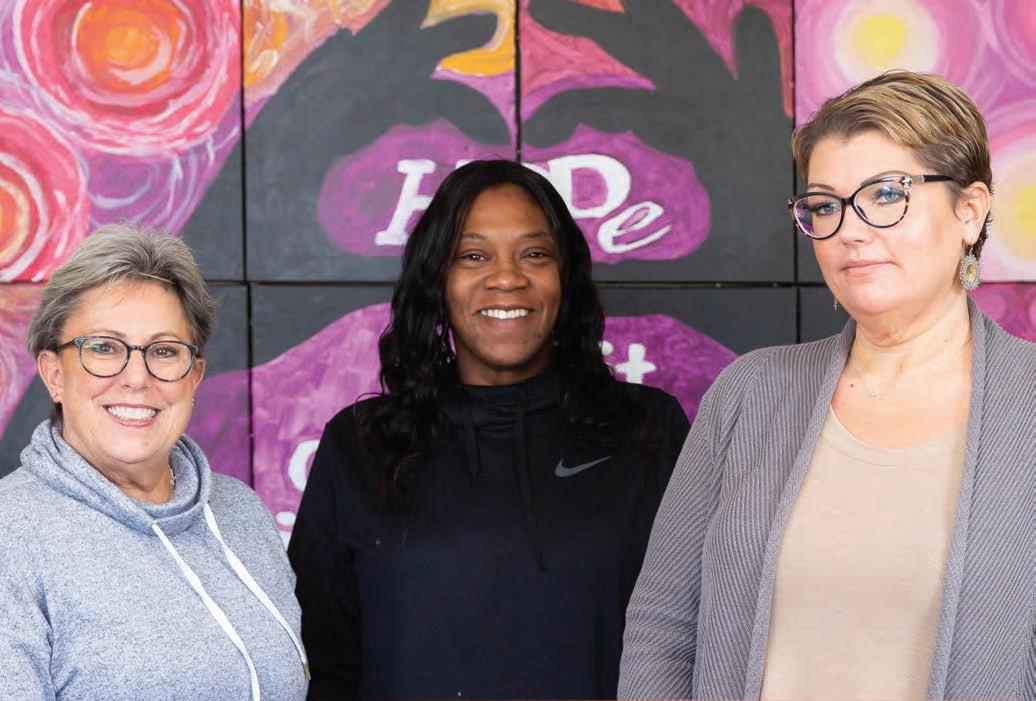
Recovery The Road to
Communities are working together By Gordon Byrd to turn the tide on the opioid epidemic

It was bitter cold, and a misty rain dogged the line of people outside a nondescript building near Cape Fear Hospital in Fayetteville.
In an archipelago of outpatient doctors’ offices that cordons the hospital, Acadia Healthcare’s Comprehensive Treatment Center is frequented by professionals, stayat-home parents, insurance agents, wounded veterans — no one has the same story, but all shared the same burden as they stood together in line one early December morning. All struggled with substance use disorders, a part of the nation’s ongoing opioid epidemic.
From 2000 to 2020, more than 28,000 North Carolinians lost their lives to drug overdose, according to the NC Department of Health and Human Services, and annual suspected overdose deaths continue to climb (see chart). But communities are banding together to help those in need, providing several potential paths to recovery.
From recovery to support
Louis Leake, clinic director at the Comprehensive Treatment Center — the largest opioid addiction treatment facility in the state — is a U.S. Army combat veteran, a pastor, and a sought-after speaker on the opioid crisis that has been gripping America’s society for over three decades. His office is small, tucked in the back of the building, but it gives him the opportunity to see each client pass as they exit. He knows many and has counseled more than a handful of them. No one demographic describes them. No archetypal story.
“We have three generations of families who attend our clinic,” he says, emphasizing that addiction to opioids is not limited to the young, or the poor, or the destitute.
Substance abuse is not limited to syringes or illicit drugs, either. “Prescription pain medications, opium, heroin and fentanyl are all opioids and affect the brain in essentially the same way,” writes Barbara AndrakaChristou, author of “The Opioid Fix.”
Louis was a paratrooper who logged more than 18 years of service and countless parachute jumps. Then, a parachuting accident left him paralyzed, with rods and screws holding his back and legs together. The pain medicine he was prescribed worked, though a creeping dependence was almost imperceptible.
“My pastor asked me to help the young men who were living in a halfway house our church ministered to,” Louis says in explaining his first step to realizing his addiction. “I heard these guys’ stories, and I thought: that sounds far too similar to my own story.”
Louis’ path to recovery was spiritual — as he puts it, he went on a spiritual retreat and came back different. He researched opioid addiction and began taking classes in a counseling program offered by the local community college. In recovery, he began counseling others.
Kennard Dubose, assistant professor in the Department of Social Work at UNC Pembroke, traces the history of addiction counseling from its earliest beginnings in Alcoholics Anonymous.
“In the past, people in recovery were the counselors for others entering recovery,” he explains. The profession of substance abuse counseling has matured since then. Now certification programs are plentiful across the states.

Suspected Overdose Deaths*
2018–2021
+26%
2,554 2,688 +5% 3,132 +15% YTD (Jan–Nov) Full year
2,351 2,471 2,844 3,595 *Estimate of statewide medical examiner system overdose deaths; the majority become confirmed as poisoning deaths. Percent change represents year-to-date (YTD) suspected overdose deaths compared to YTD total of previous year, based on available data at time of publication. Source: NC Office of the Chief Medical Examiner
Treatment centers have also proliferated. At first, abstinence-based treatments centers were the only centers available. Now, medicated assistant treatment centers are available in nearly every county of North Carolina. Abstinence-based treatment programs follow a model that is similar to Alcoholics Anonymous’ 12-step program. The people in recovery stop taking the drugs, and work through withdrawal with counseling and support from peers. Medicated assistance treatments also involve counseling and peer-support, but these treatment programs curb the symptoms of withdrawal by reducing their severity.
Both treatments work, but patients need to get to the treatment first. More local resources, as well as work to remove the stigma of substance use disorders, are making a difference.
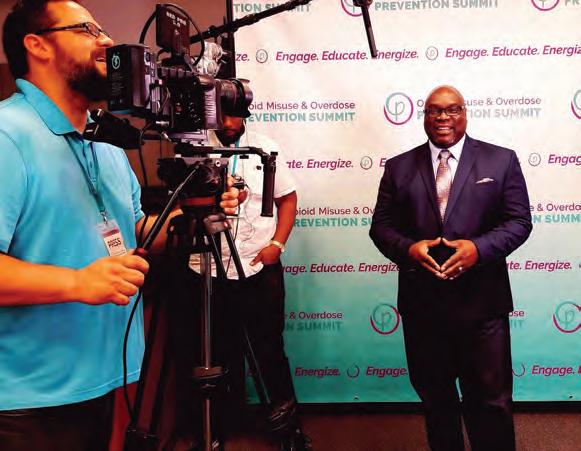
Mobilizing community
Drug Free Moore County (DFMC), which has received funding support from Central Electric, the electric cooperative based in Sanford, is a nonprofit coalition with the mission of providing educational resources, treatment information and addiction recovery support. It was organized in 1989, but with the onset of the opioid crisis has ramped up its efforts from prevention programs for school students to providing recovery support to families who are affected by substance use disorder.
DFMC Director Karen Wicker recently opened a community recovery center called Moore ReCreations in Carthage to help provide a variety of support and resources to individuals and families. The center’s goal is to help individuals “recreate” themselves during their recovery.
Moore ReCreations provides peer support services, a safe syringe program, and recovery support groups in person and via Zoom through the Moore County Detention Center. Future plans include a family support group, a reentry support group for inmates, recovery yoga, a community garden, sewing classes and other opportunities for growth and healing. DFMC is also working to provide a medically assisted treatment (MAT) program at the center through a contract with a locally established MAT program.
Karen is no stranger to the ravages of the opioid crisis. Like many, she has personal experience with opioid addiction in her family. It started innocently enough, with her daughter’s adolescent anxiety issue bringing drugs into her life as doctor-prescribed treatment.
“This, combined with peer pressure and the grief suffered from the death of her brother when she was 18, started a slow but downward spiral,” Karen explains. “There are different paths to substance use disorder, and there are different paths to recovery, too. As a parent it is hard to pinpoint what is going on until something dramatic happens.”
For Karen, it was when she received one of the worst phone calls any parent could imagine: her daughter had been air-lifted to Chapel Hill following a head-on collision. Her status was unknown. It wasn’t until several weeks later they learned substances were involved.
“When my daughter had started treatment, we did not know that, unfortunately, relapse is a part of this disease. The journey of recovery wasn’t always easy or pleasant as a parent of a loved one suffering,” Karen says. Her daughter has started a new life after being in recovery for several years. “Friends, family and people in general do not understand the heartbreak of not being able to help the one you love, or to even talk about it. Stigma is such a huge factor in families not getting the help and support they need.”
Louis Leake, who often speaks on the opioid crisis, at the 2019 Opioid Misuse and Overdose Prevention Summit in Raleigh
Taking the first step
The most important work is to remove the stigma of substance use disorders. For some, the perceived shame of addiction treatment keeps them from seeking help until it is too late.
Macon Moye, former vice president and general manager of WRFX’s John Boy and Billy network in Charlotte, first began taking pain medication for chronic knee pain. What was occasional use became daily, then became paired with alcohol. For years he refused to seek treatment until he was eventually hospitalized for more than three months.
“Two decades of drug and alcohol abuse takes a toll on your organs. They had shut down. Quit working,” he recalls of his 2012 near-death experience. Now, he is nearly a decade into recovery and supports others who are battling through recovery and the stigma associated with it through work at Chloe’s Place in Southern Pines (chloesplace.net) and at the Raleigh-based Welwynn Outpatient Center (welwynn.com).
Macon urges people who are suffering from a substance use disorder to seek treatment: “Life is too short to live dulled and desensitized.”
Carolina Country Contributing Editor Gordon Byrd is a veteran who works for UNC Pembroke. While not working or writing, he spends most of his time with family and church.
Seeking help
Are you or someone you know struggling with a substance use disorder? Contact the Alcohol and Drug Council of North Carolina at 800-688-4232 or alcoholdrughelp.org.
“Seas” Life’s Loving Moments with Your Sweetie!
PERSONALIZE IT FREE!
Shown smaller than approximate size of 61/2" wide

Celebrate your love for the beach — and each other! — with “Just Me And You With An Ocean View,” an irresistible Precious Moments® porcelain keepsake you can PERSONALIZE!
Entirely handcrafted of fine bisque porcelain!
Every detail is crafted of bisque porcelain and hand-painted, from this cute couple’s relaxed pose as they hold hands, to their colorful chairs and her tropical drink. And with their names written in the “sand,” this loving pair is “shore” of one thing — they were meant to be together forever!
Reserve it in your name today risk-free!
Send no money now to request your personal edition of “Just Me And You With An Ocean View.” Simply return the coupon and note the names you wish to include for the personalization. The issue price is payable in three payments of $36.66*; with only the first billed prior to shipment. Our 365-Day Guarantee assures your satisfaction or your money back, so there’s no risk to you. Reply today!
FOLLOW US ON
Fastest way to order:
HamiltonCollection.com/Ocean
MAIL TO:
09-08006-001-BI4
❑ YES! Please accept my order for “Just Me And You
With An Ocean View” as described in this announcement.
Fill in the two FIRST NAMES as you want them to appear:
GIRL’S NAME as you’d like it to appear.
BOY’S NAME as you’d like it to appear.
Send No Money Now!
Name__________________________________________________ (Please print clearly.) Address________________________________________________ City_________________________ State______Zip_____________ Email (Optional)__________________________________________ Signature_______________________________________________ Orders subject to acceptance.
No Taste Like Home
By Bridgette A. Lacy
On work days, Don Simmons starts at 6 a.m. ordering supplies, scheduling work shifts, and writing the daily menu on the chalkboard at Magnolia 23, his Southern cuisine restaurant in downtown Asheboro.
Throughout the day, he may wash dishes, cook the delicious pan-fried chicken, take orders and greet every customer that comes through the door of the cozy space that reminds you of your grandmother’s dining room with mirrors and pictures on the wall.
Everybody ranging from blue collar workers, families, business people and tourists eat there.
“His food is wonderful,” says Asheboro Mayor David Smith. “His fried chicken has been recognized nationally.”
Magnolia 23 opened in 2009, the same year Don retired from his position as a supervisor for Energizer Battery Inc. in Asheboro.
“The economy was rock bottom,” Don says. “But as soon as we opened, we did pretty good.”
Word of the made-from-scratch soul food and the great hospitality kept customers coming through the door. His wife, Doris, makes the melt-inyour-mouth cornbread and often runs the cash register. And ownership of the business has been passed to daughters Brittany Simmons, a physician assistant in Greensboro, and Crystal Simmons, an associate professor at SUNY Geneseo.
Don is well known beyond his restaurant and volunteers on his days off. His latest service project is organizing a free Crowder Baseball Camp, named for the late Chester Crowder of Asheboro.
“We want every kid to have a chance to play,” Don says.

Bridgette A. Lacy (bridgettelacy@att.net) is the author of “Sunday Dinner: A Savor the South cookbook.” Don Simmons
Claim to fame: Home cookin’. Magnolia 23 was voted #63 on a list of “America’s 75 Best Fried Chicken Spots” by the Daily Meal, a website dedicated to food news. Most popular dishes: Grilled pork chops, country style steak, fried catfish, mac and cheese, collards and candied yams; desserts include fried apple pie and Hershey bar cake: a chocolate cake with white icing and pieces of Hershey’s candy sprinkles on it. Read the full version of this article at carolinacountry.com/extras
MEMBERNews
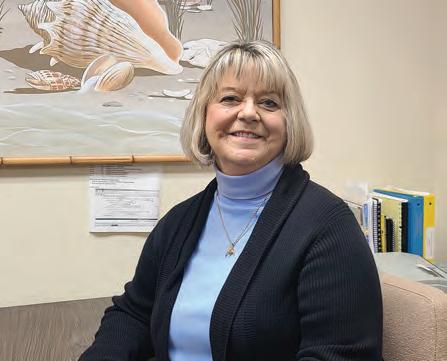
CARTERET-CRAVEN ELECTRIC COOPERATIVE
Powered by our members!
Sarah Grider Vice President of Support Services
Grider retiring after 45 years at CCEC
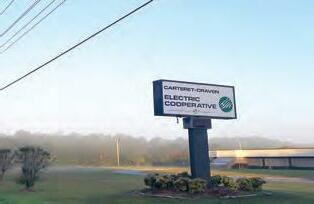

After more than 45 years of dedicated service to the cooperative, its members, and the community, Sarah Grider, vice president of support services and Carteret-Craven Electric Foundation staff liaison, is setting her sights on a well-deserved retirement.
Sarah began her co-op career in billing, then moved to payroll, spent time as a supervisor in data processing and customer service, then moved back to billing and support services. During her tenure, Sarah saw the co-op double in size, in both membership and employees. She worked under five supervisors and four general managers, and watched many long-time coworkers retire. Many of the technologies in place at the co-op today were only imagined 45 years ago when Sarah first began her career at CCEC. In 1976, meter readings were done by hand, member records were kept on index cards and the only computer at the cooperative was used for billing.
For Sarah, the co-op has been more than a place to work, it has been her home away from home, filled with coworkers that became like family. "While many things at the co-op changed over my career, the one constant has been employee dedication," said Grider. "Many employees stay for 20, 30 or, in my case, 45-plus years. There is a special bond created when people work together for that many years sharing the same common goal—the goal of providing safe, reliable and affordable energy to our membership." "Sarah helped to shape on the web many of the programs that make the co-op what Apply Now! it is today,” said CEO Community college and General Manager scholarships are available. Jake Joplin. “Although Learn more at she will be leaving ccemc.com/Scholarships us, the impact of her contributions will be felt for many years to come. We will miss her but wish her all the best.” The cooperative is woven into Sarah's DNA. "When I see a co-op truck on the road or when I see the sign in front of our offices, a certain pride builds inside of me," said Grider. "I know that I am part of Carteret-Craven Electric Cooperative and I always will be." While retirement will be a change of pace, Sarah is looking forward to traveling, spending time at her cabin in the mountains, catching up with friends, and enjoying more time on the beach with her dog, Brie.
Above, Sarah at the switchboard in the Newport office circa 1985. Below, Sarah preparing the Operation RoundUp display in the co-op's lobby. Carteret-Craven Electric Cooperative
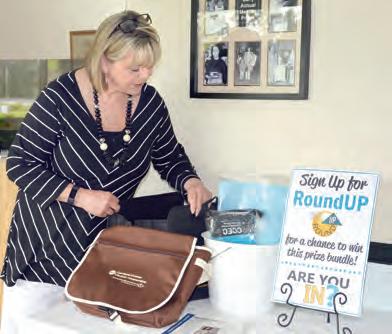
Carteret-Craven Electric Cooperative Small change helps to change lives

A lot of retail business chains have begun asking patrons if they want to “round up” their bills for a specific charity.
Co-op members have been “rounding up” since 1999, and the more than $3.75 million raised has been spread across multiple charities for the benefit of local individuals.
Through contributions of less than $1 each month, children with food insecurity receive meals and snacks for the weekend, members receive assistance with electric bills and rent payments, college scholarships are awarded, teachers receive grants and so much more. To learn more about Operation RoundUP and the programs it supports, visit ccemc.com/RoundUp.
If you are already participating in Operation RoundUP, THANK YOU! If you are not participating in RoundUP, complete the insert included with your February bill and return it in your bill envelope, or give us a call. Those who enroll in RoundUP by March 15 will be entered in a drawing for a $100 bill credit! We love serving our co-op members
February may be the shortest month, but it’s packed with special observances like Presidents’ Day, Black History Month and Valentine’s Day, in addition to a host of unofficial “national” days you’ve probably never heard of like “National Tater Tot Day.” But they all have something in common. They were created to draw attention to a particular issue or theme.
Valentine’s Day may seem like an observance originally created by a greeting card company, but over time, it’s become a widely celebrated day generating millions of dollars spent on flowers, candy and of course, greeting cards professing our love. But Valentine’s Day isn’t just for the lovebirds. It’s also the perfect time to let our friends, family, co-workers and other special people in our lives know we care about them––with or without a store-bought greeting card.
So, in that vein, we’ve created our list of top five reasons why we love serving you, the members of Carteret-Craven Electric Cooperative (CCEC). 1. We love serving our members because without you, the co-op wouldn’t exist. Our purpose is to provide you with reliable, responsible and safe electricity. Simply put, CCEC exists to serve you.
That’s why we were formed in 1940—to bring power to our local area when for-profit utilities would not.
2. You enable us to complete our mission by supporting our efforts to give back. A major part of our mission is to serve our community and look after the greater good. Because of your participation in Operation RoundUp, we’re able to provide funding to local agencies providing food and shelter for our neighbors in need, Bright Ideas
Education grants for local educators, and college scholarships for high school seniors. 3. Members of our co-op also serve on the board of directors. They provide guidance for setting co-op priorities and helping make big decisions.
Because our board members live in the area, they’re able to serve as the pulse of the larger community and identify immediate and long-term needs. The broader co-op membership provides
helpful input through their vote on director elections and by weighing in on co-op and community issues. 4. You help us get it right. CCEC members are great about keeping us in the know. We do our best to avoid power outages, but Mother Nature can occasionally throw us a curveball. We appreciate our members' patience as our crews work to safely restore power. We know outages are frustrating, and your support as we work through storms means so much to our employees. We also appreciate your feedback on co-op programs like
Connect to Save (connecttosavenc.com). Your opinions are critical for the co-op’s success, and we thank you for that. 5. You and other CCEC members make up the community we serve — and for us, it’s all about community. Our employees live and work here too and care about our community the same way you do. We’re invested and work to help it thrive.
As a co-op, our mission is to enhance the quality of life in our community and look after its long-term interests. We love serving our members and our local community, and like you, want to see it thrive.
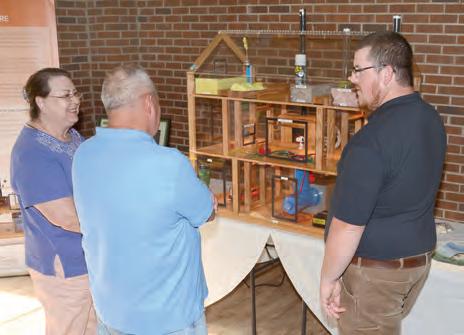
Energy Services Specialist Christian Wiedner demonstrates the "house of pressure" to members at the 2019 annual meeting.
EMBER 2022M Celebration MEETING Annual&
Planning for the 82nd Annual Meeting of CarteretCraven Electric Cooperative (CCEC) is underway. Mark your calendar for Thursday, May 5!
After holding the annual meeting virtually the past two years, we are excited to be able to meet with you again, in person, at Glad Tidings Church in Morehead City, N.C. We look forward to an evening of co-op business, entertainment, fun and prizes.
Additional information about the annual meeting, including ballots for election of directors, if needed, will appear in the April issue of “Member News.”
CCEC’s service area is divided into nine districts. The terms for the directors from districts 2, 5 and 8 expire this year. Directors are elected for three-year terms. Incumbent directors seeking nomination for 2022 are:
For District 2: Ben Ball
For District 5: Amy Lock
For District 8: Thom Styron
The Board of Directors has appointed a Nominating Committee, consisting of two members each from districts 2, 5 and 8. The committee will nominate one or more members to run for election from each of these districts.
Candidates may also be nominated by petition of 50 or more individual co-op members from their district.
Only one signature is allowed for joint accounts. The petition must be submitted and certified before 5 p.m. on March 5.
For more information about the nominating committee or petitions, contact CEO Jake Joplin at 252.247.3107.
Voting for director positions, in addition to any other business conducted as part of the annual meeting, shall be done by those who have been members at least 30 days before the meeting. Each member shall have one vote regardless of number of accounts.
District Descriptions
District 2 (Ben Ball, incumbent): Properties in Carteret County west of Highway 70, including co-op service territory along Hibbs Road, Roberts Road and Nine-Foot Road, and along Highway 24 from Dutch Treat Mobile Home Park, west through Gales Creek, Broad Creek and Bogue, up to the eastern limits of Cape Carteret. District 5 (Amy Lock, incumbent): All properties within the town limits of Emerald Isle.
District 8 (Thom Styron, incumbent): An at-large district representative from any part of the cooperative’s service area.
Bylaws Summary
To serve on the Board of Directors, members must: Ò Have been a member for no less than two years. Ò Receive electric service from CCEC at his or her primary residence, which must be in the director district that he or she represents. Ò Be a United States citizen. Ò Be at least 18 years old. Ò Not have been declared mentally incompetent unless competency has been legally restored. Ò Not have been convicted of a felony or any misdemeanor involving moral turpitude. Ò Not be a close relative of a CCEC employee or incumbent member of the Board of Directors, and, at the time of taking office, not be a close relative of a former member of the Board of
Directors who resigned from the board or died within two years before taking office. Ò Not be employed by or financially interested in a competing enterprise or a business selling electric energy, service, or supplies to CCEC, and not have been employed by CCEC or have previously been an officer or director of, or employed in any policy-making position by any electric membership cooperative or investor-owned electric utility company.
Full details of director qualifications are included in the cooperative's bylaws (ccemc.com/Bylaws).
Carteret-Craven Electric Cooperative Are portable space heaters efficient for your home?
Small space heaters are meant to do exactly as their name says: heat a small space. But unfortunately, many people use portable space heaters to heat their entire home, which can really take a toll on your energy bills. The truth is, whether you should use space heaters really depends on your home’s efficiency and energy needs.
If you’re using a space heater to compensate for problems in your home, like inadequate insulation, drafty windows and exterior doors, or an inefficient heating system, space heaters are not a practical solution. Your best bet is to improve your homes overall efficiency.
If you’re on a tight budget, caulking and weather stripping around windows and exterior doors is a low-cost, easy way to save energy. Depending on the size of your home, adding insulation can be a great next step. Loose fill insulation typically costs $1 to $1.50 per square foot. Taking these proactive energy-saving measures rather than relying on space heaters for supplemental warmth can reduce your heating and cooling bills for years to come.
Perhaps your home is energy efficient but you’re coldnatured and want a specific room to be cozier than the rest. In this case, a space heater may work for your needs. A good comparison is ceiling fans; we use ceiling fans in the summer to cool people, not rooms. A space heater can be used in a similar way during winter months. Only use a space heater in small spaces that you’re occupying and, if possible, try to shut off other rooms to contain the warmth provided by the space heater.
If you decide to use a space heater to heat a small area in your home, make sure the heater is properly sized for the space; most heaters include a general sizing table.
A word about safety: the U.S. Consumer Product Safety Commission estimates more than 25,000 residential fires are associated with the use of space heaters every year, resulting in more than 300 deaths.
If you must use a space heater, purchase a newer model that includes the most current safety features and make sure it carries the Underwriter’s Laboratory (UL) label. Choose a thermostatically controlled heater to avoid energy waste and overheating, and place the heater on a level surface away from foot traffic when in use. Remember to always keep children and pets away from space heaters.
Consider alternative ways to stay warm like extra layers of clothing or UL-approved electric blankets. If you have hardwood or tile floors, lay down area rugs to provide additional insulation (and appeal!) and maintain warmth.
We know it’s cold out there, but remember in addition to safety concerns, space heaters can greatly increase your energy bills if used improperly.
For more ways to save energy and increase comfort in your home, visit ccemc.com/EnergySavings.

Foundation scholarship deadline is March 1
CCEC and the Carteret-Craven Electric Foundation will award five scholarships to high school seniors entering college this fall.
The scholarships pay each student $1,000 a year for up to four years of college.
The program is open to students who live in a home that gets electricity from CCEC.
One student each from East Carteret, West Carteret, Croatan and Havelock high schools will be selected to receive the scholarship. The fifth recipient will be the next-highest scoring applicant and may include students from other schools, such as Jones Senior High School, early colleges, Gramercy Christian School and home schools.
The judges will weigh the following in determining the scholarship winners: need, 50 percent; academic achievement, 25 percent; and extracurricular activities, 25 percent. Additional requirements and the application are available online at ccemc.com/scholarships.
Applications are also available from the school counselors' offices and our offices in Newport and Havelock.
Offices
1300 Highway 24 Newport, NC 450 McCotter Blvd. Havelock, NC
Contact
252.247.3107 1.800.682.2217 ccemc.com customerservice@ccemc.com
Upper Class Just Got Lower Priced
Finally, luxury built for value— not for false status
Until Stauer came along, you needed an inheritance to buy a timepiece with class and refinement. Not any more. The Stauer Magnificat II embodies the impeccable quality and engineering once found only in the watch collections of the idle rich. Today, it can be on your wrist.
The Magnificat II has the kind of thoughtful design that harkens back to those rare, 150-year-old moon phases that once could only be found under glass in a collector’s trophy room.
Powered by 27 jewels, the Magnificat II is wound by the movement of your body. An exhibition back reveals the genius of the engineering and lets you witness the automatic rotor that enables you to wind the watch with a simple flick of your wrist.
It took three years of development and $26 million in advanced Swiss-built watchmaking machinery to create the Magnificat II. When we took the watch to renowned watchmaker and watch historian George Thomas, he disassembled it and studied the escapement, balance wheel and the rotor. He remarked on the detailed guilloche face, gilt winding crown, and the crocodile-embossed leather band. He was intrigued by the three interior dials for day, date, and 24-hour moon phases. He estimated that this fine timepiece would cost over $2,500. We all smiled and told him that the Stauer price was less than $100. A truly magnificent watch at a truly magnificent price!
Try the Magnificat II for 30 days and if you are not receiving compliments, please return the watch for a full refund of the purchase price. The precision-built movement carries a 2 year warranty against defect. If you trust your own good taste, the Magnificat II is built for you. Stauer Magnificat II Timepiece $399* Offer Code Price $99 + S&P SAVE $300! You must use the offer code to get our special price.
1-800-333-2045

Your Offer Code: MAG620-08 Rating of A+
Stauer ®
14101 Southcross Drive W., Ste 155, Dept. MAG620-08 Burnsville, Minnesota 55337 www.stauer.com
† Special price only for customers using the offer code versus the price on Stauer.com without your offer code.
The Stauer Magnificat II is powered by your own movement







